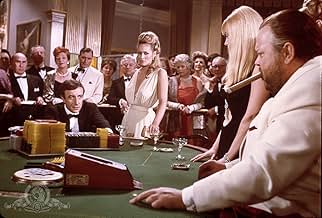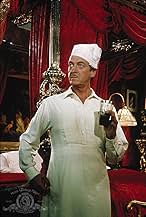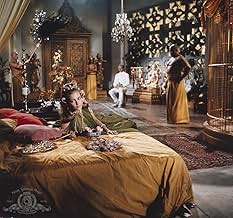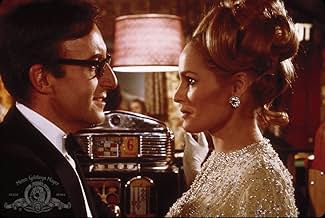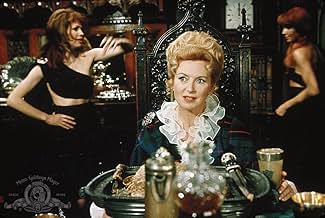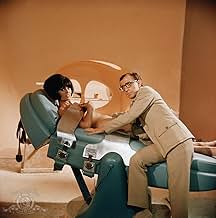IMDb-BEWERTUNG
5,0/10
33.843
IHRE BEWERTUNG
In dieser frühen Spionagefilmparodie kehrt der gealterte Sir James Bond aus dem Ruhestand zurück, um es mit SMERSH aufzunehmen.In dieser frühen Spionagefilmparodie kehrt der gealterte Sir James Bond aus dem Ruhestand zurück, um es mit SMERSH aufzunehmen.In dieser frühen Spionagefilmparodie kehrt der gealterte Sir James Bond aus dem Ruhestand zurück, um es mit SMERSH aufzunehmen.
- Für 1 Oscar nominiert
- 4 Nominierungen insgesamt
Jean-Paul Belmondo
- French Legionnaire
- (as Jean Paul Belmondo)
Empfohlene Bewertungen
To watch this movie, one must understand something that many appeared to have missed. Chiefly, the mish-mashed, ridiculous, over-blown insanity of it is the entire point. It is this that it aims for, and this that it achieves. It is not really a story, so much as every conceivable joke that could be thought of, thrown into an editing studio and spat out the other end as gold. This movie will challenge many who cannot break-out of the mold of needing a firm plot and some commonsense, but in this regard it is much like a comedic version of a David Lynch film, and I enjoyed Twin Peaks: The Movie even if I still don't get it.
So watch this for the crackling one-liners, ridiculously pretty women, lurid sets and the most completely unself-conscious approach to making a comedy that I have ever seen. It goes beyond funny, and becomes a matter of being shocked into admiration for the sheer silliness of it all. And the fun of trying to explain it to someone afterwards is immeasurable.
"So then the flying-saucer kidnaps Mata Hari and James Bond's love-child, and then James Bond who's David Niven and James Bond who's Woody Allen face-off, and meanwhile James Bond is being tortured with insane hallucinations and someone has snuck into his delusions with a machine-gun bagpipe and through all this Deborah Kerr was a French Scotswoman!"
Much less a true story than very funny surrealist art. Like Salvidor Dali meets The Pythons, but odder. And lots of great satire and stuff, too. See it. Now. If only to broaden your horizons.
So watch this for the crackling one-liners, ridiculously pretty women, lurid sets and the most completely unself-conscious approach to making a comedy that I have ever seen. It goes beyond funny, and becomes a matter of being shocked into admiration for the sheer silliness of it all. And the fun of trying to explain it to someone afterwards is immeasurable.
"So then the flying-saucer kidnaps Mata Hari and James Bond's love-child, and then James Bond who's David Niven and James Bond who's Woody Allen face-off, and meanwhile James Bond is being tortured with insane hallucinations and someone has snuck into his delusions with a machine-gun bagpipe and through all this Deborah Kerr was a French Scotswoman!"
Much less a true story than very funny surrealist art. Like Salvidor Dali meets The Pythons, but odder. And lots of great satire and stuff, too. See it. Now. If only to broaden your horizons.
During the first 30-45 minutes, you might be worried by the incomprehensible plot consisting of not very amusing scenes. If you endure this, it's getting better - not plot-wise, but there is a nice handful of insanely funny ideas. All loosely put together; I suppose having five directors hasn't helped much - still, it can be quite amusing, especially if you are slightly intoxicated.
Yes, this is a film for drunken people. Made by drunken people as well, one could think. The good actors are wasted. Towards the end the putting-together of random things gets that utterly licentious that it nearly reaches a Monty-Pythonesque quality, which I like, so I rate the movie still 6 out of 10 for this state of brash freedom in its second half.
Yes, this is a film for drunken people. Made by drunken people as well, one could think. The good actors are wasted. Towards the end the putting-together of random things gets that utterly licentious that it nearly reaches a Monty-Pythonesque quality, which I like, so I rate the movie still 6 out of 10 for this state of brash freedom in its second half.
It helps if you're able to live in Kierkegaard's unfolding moment if you want to enjoy this movie. Or in Fritz Perl's "here and now", to switch hoaxes in midstream.
It's pointless to compare "Casino Royale" to any of the other "straight" Bond films. There is no "plot" worthy of the name. The five disparate directors saw to that, to the extent that the writers didn't. It's a succession of gags, puns, and visual effects taking place in spectacularly designed settings, spoofs of German expressionism, psychedelic imagery, and all that. Some of the gags miss the mark. A British soldier who has been practicing karate chops on wooden boards comes to a stiff attention when his superior approaches and snaps a quivering Brit-style salute, knocking himself out with his own hand. Ha ha.
Such silliness abounds and at times the movie drags a bit, but there is always another joke around the corner. Orson Welles, with his fat cigar at the card table, performing magic tricks with flags and scarves amid flashing lights while everyone whistles and applauds. Peter Sellers trying on different costumes for Ursula Andress, including one of a gruff old general, "There's nothing wrong with the British Ahmy -- that a damned good swim won't cure."
You really can't look for logic in all of this. Listen to the score and watch the performers squeeze the most possible laughs out of their situations. Too bad the movie loses steam at the end so that what should be a climactic pulling together of all the accumulated lines of narrative and jokes is, instead, just plain silly -- clapping seals, parachuting Indians. Ridiculous, but not funny. Writers who have trouble ending absurd movies like this seem to think that a few minutes of chaotic slapstick will serve. "What's New, Pussycat" had the same problem, with people running frantically from room to room in a hotel, a Feydeau farce without laughs. "Sex and the Single Girl" thrust everybody into vehicles and sent them racing down a California freeway with nothing to say. Just about all of "It's a Mad, Mad, Mad, Mad World" was an attempt to substitute destruction and speed for wit.
I saw this movie when it was released and laughed from beginning to end. I don't find it quite so funny now, (I don't find ANYTHING quite so funny anymore) but I watch it when I can. It's an opportunity to live in the unfolding moment.
It's pointless to compare "Casino Royale" to any of the other "straight" Bond films. There is no "plot" worthy of the name. The five disparate directors saw to that, to the extent that the writers didn't. It's a succession of gags, puns, and visual effects taking place in spectacularly designed settings, spoofs of German expressionism, psychedelic imagery, and all that. Some of the gags miss the mark. A British soldier who has been practicing karate chops on wooden boards comes to a stiff attention when his superior approaches and snaps a quivering Brit-style salute, knocking himself out with his own hand. Ha ha.
Such silliness abounds and at times the movie drags a bit, but there is always another joke around the corner. Orson Welles, with his fat cigar at the card table, performing magic tricks with flags and scarves amid flashing lights while everyone whistles and applauds. Peter Sellers trying on different costumes for Ursula Andress, including one of a gruff old general, "There's nothing wrong with the British Ahmy -- that a damned good swim won't cure."
You really can't look for logic in all of this. Listen to the score and watch the performers squeeze the most possible laughs out of their situations. Too bad the movie loses steam at the end so that what should be a climactic pulling together of all the accumulated lines of narrative and jokes is, instead, just plain silly -- clapping seals, parachuting Indians. Ridiculous, but not funny. Writers who have trouble ending absurd movies like this seem to think that a few minutes of chaotic slapstick will serve. "What's New, Pussycat" had the same problem, with people running frantically from room to room in a hotel, a Feydeau farce without laughs. "Sex and the Single Girl" thrust everybody into vehicles and sent them racing down a California freeway with nothing to say. Just about all of "It's a Mad, Mad, Mad, Mad World" was an attempt to substitute destruction and speed for wit.
I saw this movie when it was released and laughed from beginning to end. I don't find it quite so funny now, (I don't find ANYTHING quite so funny anymore) but I watch it when I can. It's an opportunity to live in the unfolding moment.
Casino Royale has some outstanding elements. The production design is worth a 10. There are beautiful, often provocatively dressed or relatively undressed women everywhere you look. Many of its segments are funny; it's even occasionally hilarious.
The problem arose in putting all of it together. And with at least five directors and at least ten writers, it's not difficult to see why. The whole is a mess. There is little in the way of overarching plot. Most threads are just completely abandoned after awhile.
The story, which is very loosely based on Ian Fleming's James Bond novel Casino Royale (published in 1953--it's the first Bond novel), is a spoof of the typical adventure featuring the infamous secret agent. The real Bond (David Niven) went into retirement when his skills were at their peak. This Bond is quite different than the Bond we know--he is almost chaste, he's a homebody, he dedicates each evening's twilight to playing Debussy on the piano, and so on. Casino Royale has it that the Bond we know from other films is a decoy.
A group of older men, representing the secret agencies of the US, the UK, Russia and France, are on their way to the real Bond's home to ask for his assistance. It seems that someone has been trying to wipe out as many secret agents as they can. While they're pitching the idea of coming out of retirement to Bond, they're attacked. Bond's house is blown up, and he (implicitly) agrees to the assignment. Casino Royale is the story of the real Bond trying to get to the bottom of the sinister agent-wipeout plan. Part of carrying that out involves changing the identity of nearly every spy to James Bond--if the real Bond is to work unimpeded, he can't always be worrying about being killed by the criminal mastermind.
Each director worked on a different segment in relative isolation from the rest. This went so far as having their own portions of the script written. The problem was that despite Eon Productions (the production company behind most of the Bond films) not owning the rights to Casino Royale, they had used many of the "bits" in other Bond films. So there wasn't much of the book left to adapt. In addition, it was felt that a serious alternative Bond film couldn't compete against the Albert R. Broccoli/Harry Saltzman-produced films. So Casino Royale producers Jerry Bresler, John Dark and Charles K. Feldman had different writer/director teams create their own, parodic Bond segments that would be loosely tied together--it was almost a filmic version of the "Exquisite Corpse" game, in which you fold a piece of paper so that you can't see other persons' work, and you have to continue the drawing on your section with only a couple visual anchors.
Each segment features a different set of stars--the primary sets centering on Niven, Woody Allen, and Peter Sellers with Ursula Andress and Orson Welles. Those are all great actors, and great comedians in at least two cases. They all do a bit of their own schtick--in some cases, they demanded this. Woody does his neurotic New York Jew character, Peter Sellers rides the gray area between bumbling buffoon and suave playboy, with a couple generic Indian and Chinese impersonations thrown in for good measure, Orson Welles does his best Paul Masson Wine-pitching "elder statesman" demeanor, and also throws in a few of his more famous magic tricks. All of this stuff is good, but does it work as a unified film? No. And if that's not enough evidence for you, consider that the segments were further chopped up into set-pieces. There's the "M", or McTarry funeral stuff, the Niven car chase stuff, the Sellers/Andress romance stuff, and so on. Each set piece ends up being largely independent--you could almost see this as a series of skits on a similar theme. These facts make Casino Royale not quite work. It's certainly no match for a legitimate Bond film, despite the similarity of location-hopping, outrageous villains, spy gadgets and so on.
But, in isolation, the segments tend to be good to excellent. The stretch with Bond visiting the faux M widow is probably the funniest. It also presages the Sir Robin section of Monty Python and the Holy Grail (1975), but bests it in a way, if only because of its extension. The madcap ending of the film is a lot of fun for its embrace of absurdism as a supreme aesthetic disposition--and it may have even influenced some later films. And the segments with the trippiest visuals, both in the climax, are a fantastic treat for any fan of surrealism. They're good enough to watch the film just to see them. The production design is incredible throughout the film. Not just for the surrealism, but the lush Edwardian and Victorian interiors, complete with copies and works in similar styles to unique, influential artists such as Gustav Klimt and Otto Dix.
If we felt like being overly generous, we might be able to argue that the overarching mess of a plot was part of the point. This is a spoof of Bond, after all, and Bond novels and films tend to have sprawling plots--both geographically and narratively. We do travel to many exotic locales, meet many exotic people, doing exotic things, and we receive many plot intricacies and twists in both the typical Bond story and in Casino Royale. However, Bond films aren't quite convoluted or messy enough to deserve this kind of spoofing, so excusing the messiness of the whole to parodic intent seems an over-ambitious stretch.
Casino Royale is worth seeing, particularly if you're a big Bond fan or a big fan of any of the cast, or even if you just like a lot of late 1960s/early 1970s big, madcap comedies. Just don't expect anything like a tight story.
The problem arose in putting all of it together. And with at least five directors and at least ten writers, it's not difficult to see why. The whole is a mess. There is little in the way of overarching plot. Most threads are just completely abandoned after awhile.
The story, which is very loosely based on Ian Fleming's James Bond novel Casino Royale (published in 1953--it's the first Bond novel), is a spoof of the typical adventure featuring the infamous secret agent. The real Bond (David Niven) went into retirement when his skills were at their peak. This Bond is quite different than the Bond we know--he is almost chaste, he's a homebody, he dedicates each evening's twilight to playing Debussy on the piano, and so on. Casino Royale has it that the Bond we know from other films is a decoy.
A group of older men, representing the secret agencies of the US, the UK, Russia and France, are on their way to the real Bond's home to ask for his assistance. It seems that someone has been trying to wipe out as many secret agents as they can. While they're pitching the idea of coming out of retirement to Bond, they're attacked. Bond's house is blown up, and he (implicitly) agrees to the assignment. Casino Royale is the story of the real Bond trying to get to the bottom of the sinister agent-wipeout plan. Part of carrying that out involves changing the identity of nearly every spy to James Bond--if the real Bond is to work unimpeded, he can't always be worrying about being killed by the criminal mastermind.
Each director worked on a different segment in relative isolation from the rest. This went so far as having their own portions of the script written. The problem was that despite Eon Productions (the production company behind most of the Bond films) not owning the rights to Casino Royale, they had used many of the "bits" in other Bond films. So there wasn't much of the book left to adapt. In addition, it was felt that a serious alternative Bond film couldn't compete against the Albert R. Broccoli/Harry Saltzman-produced films. So Casino Royale producers Jerry Bresler, John Dark and Charles K. Feldman had different writer/director teams create their own, parodic Bond segments that would be loosely tied together--it was almost a filmic version of the "Exquisite Corpse" game, in which you fold a piece of paper so that you can't see other persons' work, and you have to continue the drawing on your section with only a couple visual anchors.
Each segment features a different set of stars--the primary sets centering on Niven, Woody Allen, and Peter Sellers with Ursula Andress and Orson Welles. Those are all great actors, and great comedians in at least two cases. They all do a bit of their own schtick--in some cases, they demanded this. Woody does his neurotic New York Jew character, Peter Sellers rides the gray area between bumbling buffoon and suave playboy, with a couple generic Indian and Chinese impersonations thrown in for good measure, Orson Welles does his best Paul Masson Wine-pitching "elder statesman" demeanor, and also throws in a few of his more famous magic tricks. All of this stuff is good, but does it work as a unified film? No. And if that's not enough evidence for you, consider that the segments were further chopped up into set-pieces. There's the "M", or McTarry funeral stuff, the Niven car chase stuff, the Sellers/Andress romance stuff, and so on. Each set piece ends up being largely independent--you could almost see this as a series of skits on a similar theme. These facts make Casino Royale not quite work. It's certainly no match for a legitimate Bond film, despite the similarity of location-hopping, outrageous villains, spy gadgets and so on.
But, in isolation, the segments tend to be good to excellent. The stretch with Bond visiting the faux M widow is probably the funniest. It also presages the Sir Robin section of Monty Python and the Holy Grail (1975), but bests it in a way, if only because of its extension. The madcap ending of the film is a lot of fun for its embrace of absurdism as a supreme aesthetic disposition--and it may have even influenced some later films. And the segments with the trippiest visuals, both in the climax, are a fantastic treat for any fan of surrealism. They're good enough to watch the film just to see them. The production design is incredible throughout the film. Not just for the surrealism, but the lush Edwardian and Victorian interiors, complete with copies and works in similar styles to unique, influential artists such as Gustav Klimt and Otto Dix.
If we felt like being overly generous, we might be able to argue that the overarching mess of a plot was part of the point. This is a spoof of Bond, after all, and Bond novels and films tend to have sprawling plots--both geographically and narratively. We do travel to many exotic locales, meet many exotic people, doing exotic things, and we receive many plot intricacies and twists in both the typical Bond story and in Casino Royale. However, Bond films aren't quite convoluted or messy enough to deserve this kind of spoofing, so excusing the messiness of the whole to parodic intent seems an over-ambitious stretch.
Casino Royale is worth seeing, particularly if you're a big Bond fan or a big fan of any of the cast, or even if you just like a lot of late 1960s/early 1970s big, madcap comedies. Just don't expect anything like a tight story.
This was the Bond title unable to be used by the filmmakers of the regular Bond film series, until the end of the century (they finally got to it for the restart in 2006). So, the intent here was a spoof of the then-wildly popular Bond/spy mania of the mid-sixties. Of course, this wasn't the first such effort; others already began the "Our Man Flint" duo film series and "The Man From UNCLE" on TV was in full swing, not to mention "Get Smart." So, how to outdo them? Get five top notch directors. Get as many sixties stars as possible. Get everything but the kitchen sink (literally, in the over-the-top climax). The original intent was to have each director do their own little mini-movie spoof - an anthology; they ended up editing everything together into one so-called film. A heady brew and, predictably, largely incomprehensible. In addition, actor Sellers, the nominal star, left before completing all his scenes, so his personal trajectory is less than smooth - as if a scene is missing, naturally. If you pay very close attention, you might be able to follow about 50% of the plot, but do you really want to put so much effort into watching a comedy?
Some of this editing is quite clumsy: the first pre-credits scene, a short one, features Sellers, as if the producers are pointing out to us that he is indeed in this movie (he doesn't show up again until 40 minutes later). Welles doesn't show up until the 80-minute mark. The first sequence concentrates on Niven, the real James Bond. He's in retirement but is forced back into a weird plot by the heads of all the world's spy agencies. This first half-hour, except for the scene with the lions, is slow and mostly stupid, not funny-stupid as intended, involving Kerr and a lot of dull fun at the expense of the Irish, for some reason, and painfully obvious joking about Bond's sexual magnetism. There's also one sly poke at the real Bond film series and its gadgetry; apparently, that Bond, of "Goldfinger" and "Thunderball" fame, is actually a replacement for the pure spy played by Niven, who looks down at the concept of gadgets. Things start to pick up a bit later, with the intro of several femme fatales, played by some of the most ravishing starlets of the sixties: Andress of "Dr.No" fame, Bouchet as the new Moneypenny, Lavi and Pettet as Bond's daughter, Mata (why Pettet did not become a major star is baffling to me). Much of the non-plot involves Niven taking over M's operations and naming a bunch of other agents James Bond to confuse the enemy - SMERSH (lifted straight from the books). We finally do see similar plot lines to Fleming's novel, involving villain heavy Le Chiffre (Welles) and one of the Bonds (Sellers) dueling at cards (Baccarat - dramatized differently in the 1954 TV version, yet eerily similar).
Curiously, it's not Sellers who provides the more amusing scenes in this confusing fest, as we would expect. No, that honor falls to Woody Allen, as Bond's nephew, and Welles in his brief scenes conducting some off-the-cuff magic show. Allen's highlight is his very first scene, involving the firing squad. Allen, previously seen in "What's New,Pussycat?," now proves to be one of the most natural comedians for the silver screen. His mannerisms and body movement recall some of the great comedians of the silent era, Chaplin & Keaton, especially evident in the scenes where he can't speak (a mental block whenever Uncle Bond is around). Famous starlet of the seventies Ms.Bisset pops up briefly in a small role as yet another femme fatale. There's also some mildly amusing commentary on the division of East and West Berlin - yes, this was the height of the Cold War - including some almost-clever use of color. But, all the psychedelic stuff, crammed into the tail end of this, is very outdated and useful only if the viewer has smoked a lot of weed. This movie also has one of the worst musical scores - almost like nails on chalkboard to me. If you're in a really good mood, you may be able to sit through this long movie comfortably; if not, you'll probably get pretty antsy as the last third begins - and that's where most of Woody's scenes are. Bonds:4 Villains:6 Femme Fatales:7 Henchmen:4 Fights:3 Stunts/Chases:5 Gadgets:4 Locations:8 Pace:4 overall:5-
Some of this editing is quite clumsy: the first pre-credits scene, a short one, features Sellers, as if the producers are pointing out to us that he is indeed in this movie (he doesn't show up again until 40 minutes later). Welles doesn't show up until the 80-minute mark. The first sequence concentrates on Niven, the real James Bond. He's in retirement but is forced back into a weird plot by the heads of all the world's spy agencies. This first half-hour, except for the scene with the lions, is slow and mostly stupid, not funny-stupid as intended, involving Kerr and a lot of dull fun at the expense of the Irish, for some reason, and painfully obvious joking about Bond's sexual magnetism. There's also one sly poke at the real Bond film series and its gadgetry; apparently, that Bond, of "Goldfinger" and "Thunderball" fame, is actually a replacement for the pure spy played by Niven, who looks down at the concept of gadgets. Things start to pick up a bit later, with the intro of several femme fatales, played by some of the most ravishing starlets of the sixties: Andress of "Dr.No" fame, Bouchet as the new Moneypenny, Lavi and Pettet as Bond's daughter, Mata (why Pettet did not become a major star is baffling to me). Much of the non-plot involves Niven taking over M's operations and naming a bunch of other agents James Bond to confuse the enemy - SMERSH (lifted straight from the books). We finally do see similar plot lines to Fleming's novel, involving villain heavy Le Chiffre (Welles) and one of the Bonds (Sellers) dueling at cards (Baccarat - dramatized differently in the 1954 TV version, yet eerily similar).
Curiously, it's not Sellers who provides the more amusing scenes in this confusing fest, as we would expect. No, that honor falls to Woody Allen, as Bond's nephew, and Welles in his brief scenes conducting some off-the-cuff magic show. Allen's highlight is his very first scene, involving the firing squad. Allen, previously seen in "What's New,Pussycat?," now proves to be one of the most natural comedians for the silver screen. His mannerisms and body movement recall some of the great comedians of the silent era, Chaplin & Keaton, especially evident in the scenes where he can't speak (a mental block whenever Uncle Bond is around). Famous starlet of the seventies Ms.Bisset pops up briefly in a small role as yet another femme fatale. There's also some mildly amusing commentary on the division of East and West Berlin - yes, this was the height of the Cold War - including some almost-clever use of color. But, all the psychedelic stuff, crammed into the tail end of this, is very outdated and useful only if the viewer has smoked a lot of weed. This movie also has one of the worst musical scores - almost like nails on chalkboard to me. If you're in a really good mood, you may be able to sit through this long movie comfortably; if not, you'll probably get pretty antsy as the last third begins - and that's where most of Woody's scenes are. Bonds:4 Villains:6 Femme Fatales:7 Henchmen:4 Fights:3 Stunts/Chases:5 Gadgets:4 Locations:8 Pace:4 overall:5-
Wusstest du schon
- WissenswertesPeter Sellers and Orson Welles hated each other so much that the filming of the scene where both of them face each other across a gaming table actually took place on different days with a double standing in for the other actor.
- PatzerIn the "vault" scene towards the end, Bond says, "Careful, it's vaporized lysergic acid, highly explosive". Lysergic acid, used in the synthesis of the hallucinogen LSD, is not explosive at all.
- Zitate
Piper: Excuse me. Are you Richard Burton?
Evelyn Tremble: No, I'm Peter O'Toole!
Piper: Then you're the finest man that ever breathed.
- Crazy CreditsThe opening credit animation by Richard Williams parodies illuminated manuscripts with cartoon-style calligraphy. It sets the tone for the film as a psychedelic "knight's tale" of Sir James Bond.
- Alternative VersionenIn the Region 2 DVD which has English, German, French, Italian and Spanish audio tracks, the ending is left instrumental in Spanish audio track unlike the others.
- VerbindungenEdited into The Clock (2010)
Top-Auswahl
Melde dich zum Bewerten an und greife auf die Watchlist für personalisierte Empfehlungen zu.
Details
- Erscheinungsdatum
- Herkunftsländer
- Sprachen
- Auch bekannt als
- Казино Рояль
- Drehorte
- Produktionsfirma
- Weitere beteiligte Unternehmen bei IMDbPro anzeigen
Box Office
- Budget
- 12.000.000 $ (geschätzt)
- Weltweiter Bruttoertrag
- 2.783 $
- Laufzeit2 Stunden 11 Minuten
- Farbe
- Seitenverhältnis
- 2.39 : 1
Zu dieser Seite beitragen
Bearbeitung vorschlagen oder fehlenden Inhalt hinzufügen



